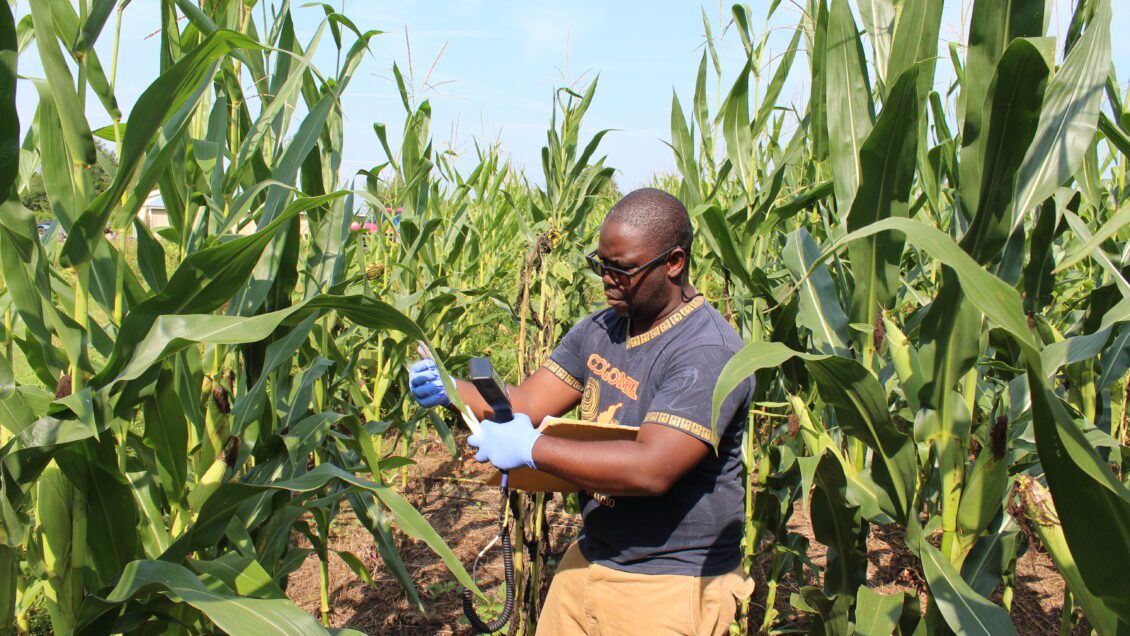
A team of Clemson University researchers has found certain cover crops do not compete with cash crops for nutrients and water when grown in upstate South Carolina’s sandy loam soils.
The team, led by Clemson scientist Sruthi Narayanan, an associate professor of crop ecophysiology in the Department of Plant and Environmental Sciences, interseeded three cover crops – white clover, buckwheat and pigeon pea with silage corn, a cash crop. Interseeding involves growing cover crops in the same field at the same time as a cash crop.

“Interest in cover cropping and conservation tillage is growing among row crop farmers in the Southern United States because these practices improve soil health, biodiversity in agroecosystems and resilience to extreme weather,” Narayanan said. “However, long cash-crop seasons in the South limit the window for the successful establishment of off-season, or fall, cover crops.”
Conservation tillage is any tillage practice that helps to minimize the impact of water and wind erosion. The latest figures from the United States Department of Agriculture (USDA) show the use of cover crops increased by 50% between 2012 and 2017.
Interseeding cover crops
Interseeding summer cover crops alongside cash crops could increase the viability of including cover crops in the Southern production systems. Interseeding summer cover crops before cash crops mature could increase windows of cover crop establishment and improve the viability of cover cropping in the Southern production systems.
An interseeded system is an example of sustainable intensification of cropping systems as it enhances biodiversity as interseeded cover crops tend to suppress pest pressure, reducing pesticide use. In addition, interseeded cover crops can also suppress weed infestation, reducing herbicide use as they cover the ground between the cash crop rows.
One main concern with cover crop interseeding is the possibility of cover crops acting as weeds and competing with the main crops for water and nutrients. In this study, the researchers found cover crops did not affect silage corn height and aboveground biomass production. They also found cover crops did not deplete the amount of water available in the soil.
“These results are encouraging for farmers who are considering interseeding cover crops with corn grown in regional production systems,” said Ricardo St. Aime, climate-smart peanut Clemson Cooperative Extension Service associate, post-doctoral researcher and Laspau Fulbright Scholar in the Department of Plant and Environmental Sciences, who worked with Narayanan on the project.
Cover crops for this study
The study involved on-farm trials under rain-fed conditions in sandy loam soils in a field in Pendleton, South Carolina. The field contained native clover and had been used as a pasture for cattle. No crops had been grown on the field in the past 30 years. Fertilizer was applied according to recommendations made after soil tests were conducted in the Clemson Ag Service Laboratory.
Corn hybrids planted for the study were P2089VYHR and P2088YXR. The cover crops were planted between the rows of corn as single species or as a 3-species mixture. The researchers evaluated the effects of interseeded cover crops on corn plant height and aboveground biomass production.
Buckwheat, white clover and pigeon pea were selected as cover crops because they pose very little competition with companion cash crops while they have the potential for enhancing microbial communities, nutrient cycling and natural pest control benefits in Southern soils.
Buckwheat can produce a quick ground cover, supply plants with phosphorus from soil, rejuvenate low-fertility soils, attract beneficial insects and suppress weeds. It also produces an abundance of fine roots which make it easier for roots to penetrate the soil.
Just as buckwheat, white clover also establishes rapid ground cover, as well as helps reduce soil erosion, enhance soil fertility and suppress weeds and pests. It also fixes nitrogen and assists in supplying plants with phosphorus from the soil.
A deep root system with a strong taproot is what makes pigeon pea a good cover crop choice for compacted soils in the southeastern United States. Pigeon pea is well-suited for cover cropping as it draws more water from deeper soil depths than most legumes without interfering with water uptake of cash crops.
“Successful establishment of interseeded cover crops will depend upon many factors such as cover crop species, interseeding method, seeding rate, soil tilth, precipitation, and light penetration,” Narayanan said. “Our future studies will evaluate many of these factors.”
In future studies, the researchers also will evaluate different soil types.
A paper about the project, Interseeded cover crops did not reduce silage corn performance in the sandy loam soils of South Carolina, can be found in Agrosystems, Geosciences and Environment at https://doi.org/10.1002/agg2.20364. This research was funded by the Southern Sustainable Agriculture Research and Education (SARE) grant number OS20-133.
Climate change is forcing producers, ranchers, forest landowners and communities across the country to develop new ways to continue to remain sustainable. Cover crop interseeding is one climate-smart practice used to enhance the climate resilience of production systems. According to Narayanan, climate-smart practices are essential in many aspects of everyday life and are important in protecting the earth for future generations.
-END-
Get in touch and we will connect you with the author or another expert.
Or email us at news@clemson.edu
